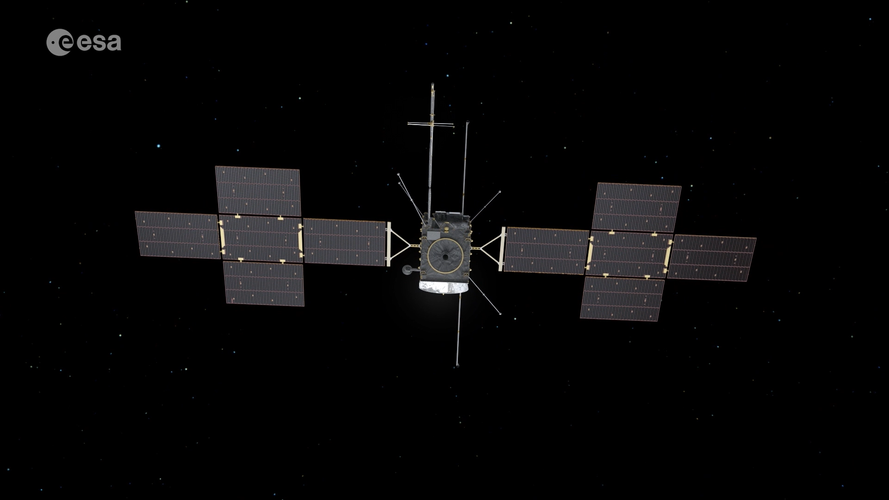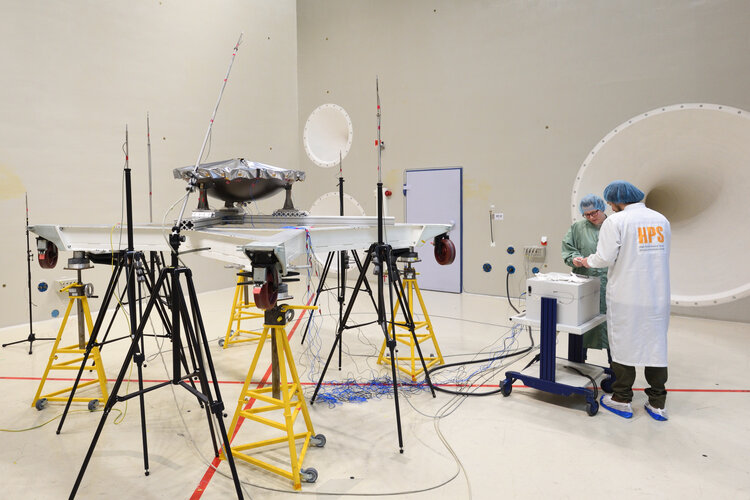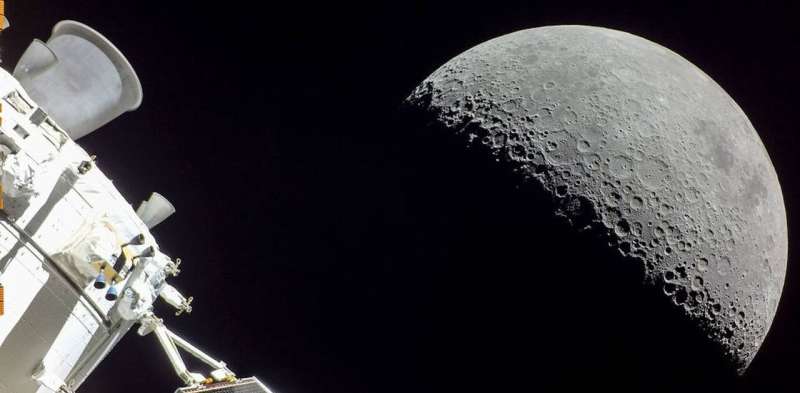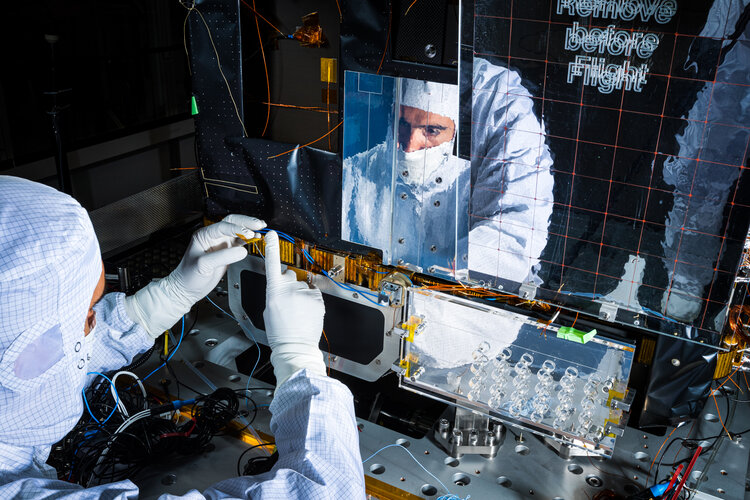
Copernical Team
Juice’s odyssey of exploration
 Video:
00:03:21
Three-minute cinematic video trailer presenting ESA’s Jupiter Icy Moons Explorer (Juice) mission
Video:
00:03:21
Three-minute cinematic video trailer presenting ESA’s Jupiter Icy Moons Explorer (Juice) mission Sound test of Hera asteroid mission antenna
 Image:
Sound test of Hera asteroid mission antenna
Image:
Sound test of Hera asteroid mission antenna More lunar missions means more space junk around the Moon—two astronomers are building a catalog to track the trash

Scientists and government agencies have been worried about the space junk surrounding Earth for decades. But humanity's starry ambitions are farther reaching than the space just around Earth. Ever since the 1960s with the launch of the Apollo program and the emergence of the space race between the U.S. and Soviet Union, people have been leaving trash around the moon, too.
Today, experts estimate that there are a few dozen pieces of space junk like spent rocket bodies, defunct satellites and mission-related debris orbiting in cislunar space—the space between Earth and the moon and the area around the moon. While this isn't yet a large amount of junk, astronomers have very little information about where these pieces of space debris are, let alone what they are and how they got there.
Sentinel-4 set to join next weather satellite

Copernicus Sentinel-4, which is set to play a key role in monitoring air quality over Europe, is ready to be fitted to its host, the first Meteosat Third Generation Sounder weather satellite.
Copernicus Sentinel-4 is a state-of-the-art ultraviolet, visible, near-infrared spectrometer instrument that has been developed to deliver hourly high-resolution measurements of trace gases such as nitrogen dioxide, ozone, sulphur dioxide and formaldehyde, as well as aerosols.
Galileo signal component tested for Internet of Things use

One of Europe's Galileo satellites has been reconfigured to emit a new signal component optimised to serve low-end receiver devices and Internet of Things applications.
Spanish lagoon used to better understand wet-to-dry transition of Mars
 In the ongoing search for signs of life on Mars, a new study proposes focusing on "time-resolved analogs" - dynamic and similar Earth environments where changes can be analyzed over many years.
Alberto Fairen, visiting scientist of astronomy at Cornell University, led an investigation in the extremely salty Tirez lagoon in central Spain, which had experienced alternating dry and wet period
In the ongoing search for signs of life on Mars, a new study proposes focusing on "time-resolved analogs" - dynamic and similar Earth environments where changes can be analyzed over many years.
Alberto Fairen, visiting scientist of astronomy at Cornell University, led an investigation in the extremely salty Tirez lagoon in central Spain, which had experienced alternating dry and wet period Bringing more power to Space Station
 A new cargo mission stands ready to launch early Thursday and dock to the International Space Station two days later. Meanwhile, the Expedition 68 crew switched roles between space scientists and orbital plumbers on Wednesday promoting advanced knowledge and maintaining life support systems.
A rocket packed with about three tons of food, fuel, and supplies, is ready to launch from the Baik
A new cargo mission stands ready to launch early Thursday and dock to the International Space Station two days later. Meanwhile, the Expedition 68 crew switched roles between space scientists and orbital plumbers on Wednesday promoting advanced knowledge and maintaining life support systems.
A rocket packed with about three tons of food, fuel, and supplies, is ready to launch from the Baik Faster, more accurate 3D modelling recreates a landscape's digital twin down to the pixel
 Concordia researchers have developed a new technique that can help create high-quality, accurate 3D models of large-scale landscapes - essentially, digital replicas of the real world. While more work is required before the researchers achieve their goal, they recently outlined their new automated method in the Nature journal Scientific Reports.
The framework reconstructs the geometry, stru
Concordia researchers have developed a new technique that can help create high-quality, accurate 3D models of large-scale landscapes - essentially, digital replicas of the real world. While more work is required before the researchers achieve their goal, they recently outlined their new automated method in the Nature journal Scientific Reports.
The framework reconstructs the geometry, stru Comtech receives additional funding for US Army Communications
 Comtech (NASDAQ: CMTL) reports it has received a contract for four VSAT III Satellite Systems and Services task order modifications exceeding $20 million dollars, under the Global Tactical Advanced Communication Systems (GTACS) IDIQ award, to support global U.S. Army operations.
"With the convergence of space and terrestrial communications, the seamless mobility of information is paramount
Comtech (NASDAQ: CMTL) reports it has received a contract for four VSAT III Satellite Systems and Services task order modifications exceeding $20 million dollars, under the Global Tactical Advanced Communication Systems (GTACS) IDIQ award, to support global U.S. Army operations.
"With the convergence of space and terrestrial communications, the seamless mobility of information is paramount Shenzhou XV astronauts to conduct first spacewalk
 The Shenzhou XV mission crew, who are now inside the Tiangong space station, are scheduled to carry out their first spacewalk soon, according to the China Manned Space Agency.
The agency said in a brief news release on Wednesday afternoon the Shenzhou XV astronauts - mission commander Major General Fei Junlong, Senior Colonel Deng Qingming and Senior Colonel Zhang Lu - had lived inside the
The Shenzhou XV mission crew, who are now inside the Tiangong space station, are scheduled to carry out their first spacewalk soon, according to the China Manned Space Agency.
The agency said in a brief news release on Wednesday afternoon the Shenzhou XV astronauts - mission commander Major General Fei Junlong, Senior Colonel Deng Qingming and Senior Colonel Zhang Lu - had lived inside the 
